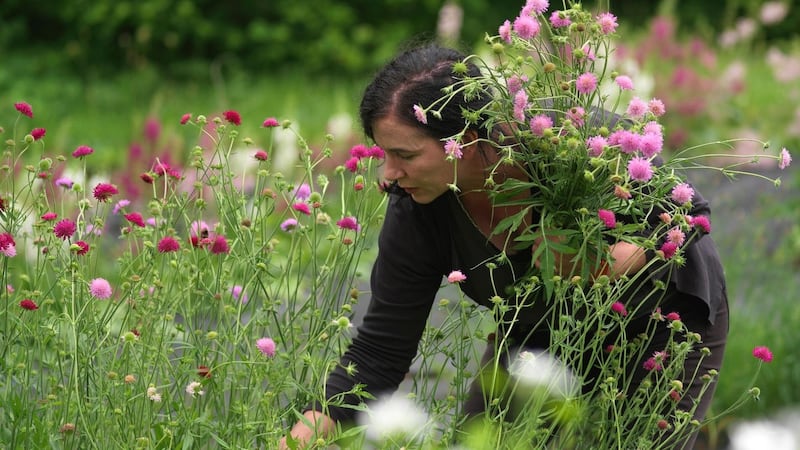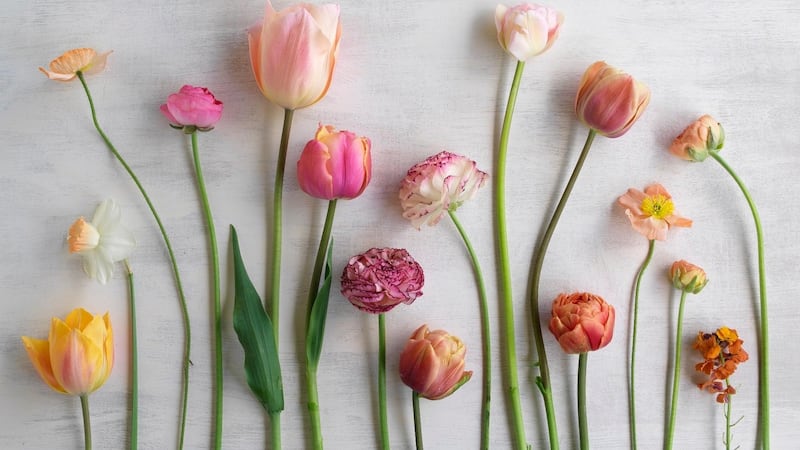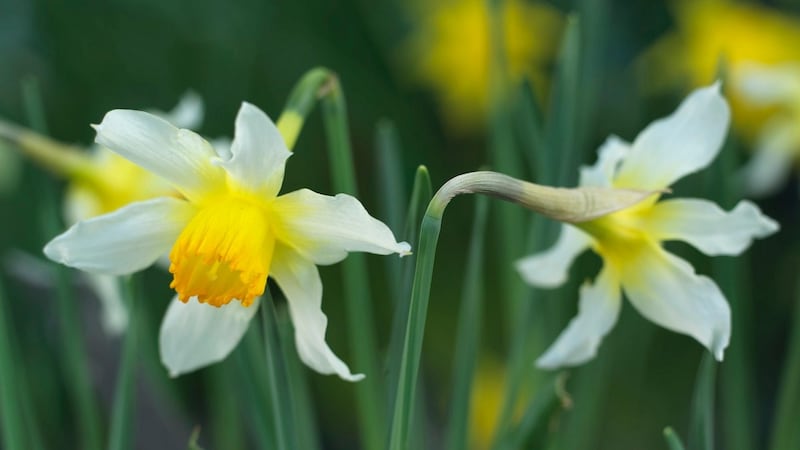If you love gardening, then you probably also love growing flowers. But as for picking them? Let’s just say that I have countless gardening friends who would rather cut their arm off than pluck a handful of blooms from their beautifully tended borders. Even the mere sight or sound of a secateurs slicing through a succulent flower stem is enough to make them wince. As for any of their loved ones who have the temerity to ignore this unspoken gardener’s rule, the punishment is usually swift (and severe.) All of which is why the Victorian idea of a cut-flower patch, where blooms are grown exclusively for cutting, is such a wonderful idea. There’s no guilt. No palaver. No tears or ticking-offs. Instead flowers are grown in neat rows as crops to be harvested, in exactly the same way as vegetables.
Indeed, the ideal location for a cut-flower patch is the very same as it would be for a vegetable patch. So a sunny, open spot in the garden or allotment and a soil that’s weed-free, friable (nicely crumbly rather than sticky or compacted), fertile and free-draining. As for the size of your cut-flower patch, my suggestion is to start small (again, just as for vegetable gardening) and see how you fare.

Along with the joy that comes from filling your vases with homegrown, seasonal blooms, much of the magic of cultivating your own cut-flowers is about growing them from seed, cuttings and division, all traditional methods of propagation that allow us gardeners to produce plenty of plants at very little cost. So the tools-of-the-trade for any would-be flower farmer include a small and inexpensive electric propagator, plant labels, some good quality seed/cutting compost, plus some freezer bags and elastic bands to cover your pots of freshly-sown seed or freshly-taken cuttings until you see signs of new life.
Full flower
When and if possible, try to use a peat-free compost (Klasmann's organic seed compost is great) and source organically-certified seeds, plants, and bulbs that haven't been pre-treated with environmentally-harmful fungicides or insecticides such as neonics. Recommended stockists include Cork-based Fruithill Farm who currently have a small range of organically-certified dahlia tubers and gladiolus bulbs in stock, both of which are excellent choices for a cut-flower patch and which if planted this month, will be in full flower by summer. They also stock a small range of organically-certified seed of cut-flower varieties as do Galway-based seed suppliers, Seedaholic (seedaholic.com), and Leitrim-based The Organic Centre (theorganiccentre.ie).

You'll also find seed of many popular, pollinator-friendly cut-flower varieties for sale in your local garden centre at this time of year, many of which can be sown in the coming weeks to provide months of cut-flowers. Examples include hardy annuals such as calendula, nigella, cornflowers, honeywort (Cerinthe 'Purpurascens'), clary sage (Salvia viridis), sweet pea, Bishop's flower (Ammi majus and Ammi visnaga), orlaya and annual mallow (Lavatera trimestris) as well as half-hardy annuals such as cosmos, amaranthus, dill, Tagetes 'Cinnabar', Bells of Ireland (Molucella laevis), nasturtium, nicotiana, annual rudbeckia and scabious.
Come early summer, you can also sow seed of beautiful biennial species of cut-flowers such as wallflowers, Sweet William, foxgloves, Icelandic poppies and honesty.
These sorts of fast-growing annuals and biennials aside, it’s well worth popping some long-lived, ultra-reliable perennials into any cut-flower patch. Examples include astrantia, astilbe, knautia, Solomon’s seal or Polygonatum x hybridum, alchemilla, linaria, peonies, alstroemeria, penstemon, agapanthus, asters, crocosmia, Japanese anemones and phlox. All are available from good Irish garden centres and specialist nurseries at this time of year and can be planted in the coming weeks.
Shrubby plants also play a very useful role in a cut-flower patch, some for their flowers, others for their foliage and a few (the great all-rounders) for both. Examples include physocarpus, brachyglottis, pittosporum, rosemary, floribunda roses, viburnum, lilac, cotinus, black-leaved elder and hydrangea.Whatever your final choice, the aim should be to end up with a selection that give you plenty of seasonal cutting-material to use throughout the year rather than just a short-lived summer glut.
As for the best ways to keep your cut-flower patch in bonny good health, my advice is to concentrate on time-proven, organically-acceptable, planet-friendly methods. So avoid synthetic fertilisers and environmentally-damaging sprays in favour of natural soil conditioners such as homemade compost, manure and seaweed powder. You can also help prevent pests and diseases by boosting plant health with homemade liquid feeds of nettle, comfrey and seaweed. Other common pests such as slugs can be controlled by careful handpicking rather than resorting to toxic slug pellets. As for weeds, the best way to keep these under control is by starting off with a weed-free plot. By planting densely and using mulches (cardboard, leaf-mould, well-rotted manure), you’ll help prevent new weeds from germinating while any that do appear can be nipped in the bud with regular hoeing.
Vase life
For maximum vase life, harvest your home-grown cut flowers and foliage either early in the morning or late in the evening, then strip away the lower leaves and quickly pop the stems up to their necks in a bucket of cold, clean water before placing this somewhere cool, dry, and dark overnight to properly “condition” them . Last but not least, avoid the use of floral foam when it comes to arranging your beauteous blooms. Non-biodegradable and packed full of noxious chemicals, it’s bad for the environment as well as for you. A far healthier, much more sustainable alternative is a gently scrunched-up, re-usable ball of chicken wire (squeeze it into the vase) or the now-fashionable metal “flower frogs” that our oh-so-wise grandmothers once used.
Deadheading will also encourage the bulbs to plump up and produce plenty of flowers
Learn to grow
Want to know more about growing your own cut flowers? Well-known Irish flower farmers Ciaran and Kealin Beattie of Leitrim Flowers are holding a series of courses over the coming months, including a one-day workshop Creating a Cut Flower Garden on May 20th (10am-4pm, €70), see leitrimflowers.ie, while Fionnuala Fallon will be giving a talk followed by a workshop (pre-booking essential) on How to Grow Your Own Cut-Flowers and Foliage Seasonally and Sustainably at Killruddery House and Gardens in Co Wicklow on April 29th (from 12pm, see killruddery.com for booking details). Also check out flowerfarmersofireland.ie, the newly launched website of Flower Farmers of Ireland, a countrywide collective of small scale cut-flower growers
This Week In the Garden
Hoe away
Now that temperatures are improving and light levels are increasing, it’s important to keep on top of fresh weed growth before it gets out of hand by using a hoe (my favourite kinds are the swoe and the oscillating hoe) to slice away young weed seedlings before they establish strong root systems. Make sure to pick a dry bright day to do this as otherwise there’s a good chance of some of the seedlings quietly re-establishing their roots in the ground.

What to do with daffodils
Daffodils (Narcissus) are in flower in many gardens at the moment, adding a much-needed flash of brilliant colour to meadows, borders and containers. To encourage healthy, vigorous growth and plenty of flowers for next spring, it’s important to allow their strappy foliage to naturally die back rather than cutting it away or bundling it together with elastic bands as is sometimes seen. Deadheading will also encourage the bulbs to plump up and produce plenty of flowers next spring but the downside is that it prevents the plants from naturalising (self-seeding). So if naturalistic drifts of flowers is what you’re aiming for, don’t deadhead, while if the bulbs are growing in a lawn or rough grass, don’t mow for at least six weeks after flowering has finished. The same is true for other spring-flowering bulbs that you’d like to naturalise in your garden such as crocuses, snowdrops, cyclamen, anemones etc.
Plant garlic
As long as the soil in your garden has dried out and warmed up after last month’s Siberian weather, this is a good time to plant onion, shallot and garlic sets, all of which are available to buy from good Irish garden centres as well as from online specialist suppliers. Like most members of the allium family, these like a weed-free, very well-drained, fertile (but not recently manured) soil in full sun. To help avoid the risk of diseases such as onion white rot, avoid planting them in a spot where you’ve recently grown members of the allium family. To prevent birds from uprooting newly-planted sets, cover them with a layer of netting or enviromesh.
Dates for your diary
Today, Saturday, April 7th, 3pm-5pm, Delgany and District Horticultural Society Annual Daffodil Show, Old Schoolhouse, Delgany, Co Wicklow, see delganydhs.com;
Tomorrow, Sunday, April 8th, 11am-5.30pm, Claregalway Spring Fair, Claregalway Castle, Co Galway, admission €5, see claregalwaycastle.com;
Wednesday, April 11th (8pm), Airfield Estate, Dundrum, Dublin, “Airfield, a work in progress”, a talk by Airfield’s head gardener Colm O’ Driscoll on behalf of the RHSI, members free, non-members €5-€10, see rhsi.ie;
Saturday, April 14th (2.30pm-4.30pm), St Nessan’s Community School, Moyclare Rd (off Warrenhouse Rd), Baldoyle, Dublin 13, Howth & Sutton Horticultural Society Annual Spring Show, see hshs.ie;
Sunday, 15th April (2pm-5pm), Malahide Horticultural Society Spring Show and Plant Sale, St Andrew's Parish Centre, Church Road, Malahide, Co Dublin, see malahidehorticulturalsociety.com.
















